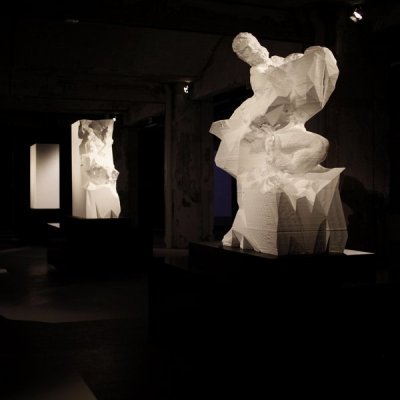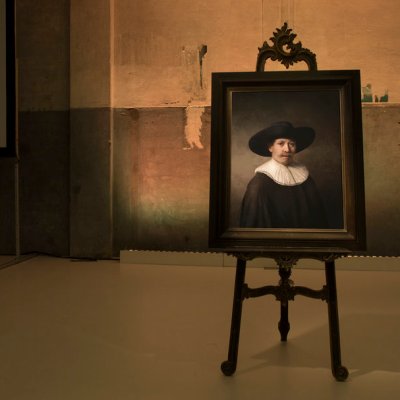Anya Gallaccio is an artist known for her work with natural forms and organic matter, as in the instantly-recognisable wall of flowers that comprises preserve ‘beauty’. So at first glance, Beautiful Minds, her new installation at Thomas Dane Gallery, confounds expectations. A computer-controlled hose, suspended from a spare, elegant gantry that spans the ceiling, pumps out wet clay in a series of hexagonal forms. Slowly, over a period of weeks, this gigantic 3D printer will build layer upon layer of clay hexagons, until a recognisable form emerges: a scaled model of a mountain; Devil’s Tower, Wyoming. Devil’s Tower, a sacred Native American site, was also the location of the alien landing in Spielberg’s Close Encounters of the Third Kind, and the mountain embodies the contradictions inherent in Gallaccio’s work: ancient, visceral landscapes forming the backdrop to futuristic technological interventions.
This work is a product of Gallaccio’s time in California, a collaboration with her students at UC San Diego, and the landscape/technology dichotomy is further apparent in the Californian identities that influence the piece. The artist, who is ‘obsessed with the desert, the sand, the landscape’ around San Diego, also drew upon the technical inventiveness for which California is renowned to construct the 3D printer. The result is an installation that mediates between (wo)man and machine, bringing into question the identity of the beautiful mind for which the work is named – is it the mind of the artist, or of the computer, which is paramount here? Does the 3D printer become the proxy hand of the artist? Gallaccio sees the 3D printer as a tool; a means, rather than an end, which is usually rendered invisible but is deliberately brought forward here.
‘Anya Gallaccio: Beautiful Minds’ at Thomas Dane Gallery, London, 2017. Courtesy the artist and Thomas Dane Gallery, London. Photo Todd-White Art Photography

This work, therefore, is as much a performance as an installation, in which the process of creation, and the machinery which enables it, is integral to understanding and engaging with the mound of clay that grows ominously beneath. The machinery of creation becomes part of the piece itself, bringing into contention the parameters of the work. When the apparatus rumbles into life, a symphony of sepulchral wails and moans fill the space, giving the printing process a kind of melancholy grandeur, as if the span of geological time had been sped up to produce the mountain that emerges, slips and cracks before our eyes. When the print is complete, it will be broken up and the clay disposed of in an act of cataclysmic finality. Challenging the perception of 3D printing as a clinical, accurate form of technological reproduction, the work celebrates the imperfections and ephemerality of organic forms, even as these emerge from a highly sophisticated piece of human-made equipment. Gallaccio’s intervention, a welcome and highly necessary meditation on the relationship between tech and techne, is a visual and cerebral spectacle.
‘Anya Gallaccio: Beautiful Minds’ is at Thomas Dane Gallery, London, until 25 March.





